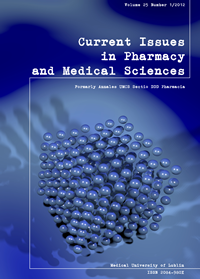The influence of excipients on physicochemical properties of Miglyol 812 – based oleogels
DOI:
https://doi.org/10.12923/j.2084-980X/25.1/a.15Keywords:
rheology, oleogels, medium-chain triglyceridesAbstract
In this paper, we presented the technology of preparation, as well as quality evaluation methods of the lipophilic gel based on a medium chain triglyceride (MCT) – Miglyol 812. In so doing, glyceryl stearate and glyceryl dibehenate were used as the gelling agents. The compounded gels were analyzed in terms of organoleptic properties, microscopic analysis, and rheological properties (yield point, thixotropy, viscosity at shear rates 10, 100 and 1000 s-1). Following this, two model active substances: hydrocortisone (2%) as the lipophilic one, and oxytetracycline hydrochloride (0,5%) as the hydrophilic one, were incorporated into gels made of Miglyol 812 and 15% glyceryl stearate. After this, the influence of these active substances on the properties of gel was investigated. Moreover, a spectrophotometric method of content evaluation of these substances in a gel was established.
References
1. Almeida I. F. et al.: Optimazation and rheological characterization of an oleogel of cholesterol and mineral oil. e-rheo.pt, 2, 9, 2002.
2. Almeida I. F. and Bahia M.F.: Comparison of the mechanical properties of two oleogels. e-rheo.pt, 5, 12, 2005.
3. Almeida I. F. and Bahia M.F.: Evaluation of the physical stability of two oleogels. Int. J. Pharm., 327, 73, 2006.
4. Barnes H. A.: Thixotropy – a review. J. Non-Newtonian Fluid Mech., 70, 1, 1997.
5. Lescanne M. et al.: Structural Aspects of the Gelation Process Observed with Low Molecular Mass Organogelators. Langmuir, 19, 2013, 2003.
6. Mewis J. and Wagner N.J.: Thixotropy. Adv. Colloid. Interface Sci., 147-148, 214, 2009.
7. Penzes T., Csoka I. and Eros I.: Rheological analysis of the structural properties effecting the percutaneous absorption and stability in pharmaceutical organogels. Rheol. Acta, 43, 457, 2004.
8. Placin F., Colomes M. and Desvergne J. P.: A New Example of Small Molecular Non-Hydrogen Bonding Gelators for Organic Solvents. Tetrahedron Lett., 38, 2665, 1997.
9. Vintiloiu A. and Leroux J.: Organogels and their use in drug delivery - A review. J. Control. Release, 125, 179, 2008.
Downloads
Published
Issue
Section
License
Copyright (c) 2012 Authors

This work is licensed under a Creative Commons Attribution-NonCommercial-NoDerivatives 3.0 Unported License.


